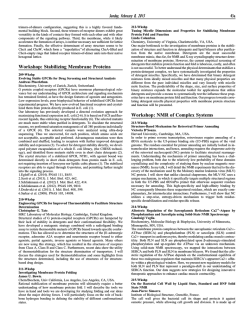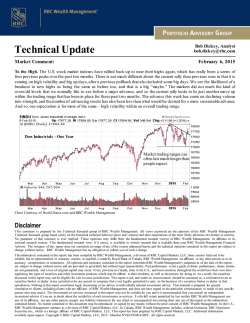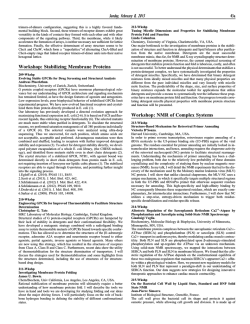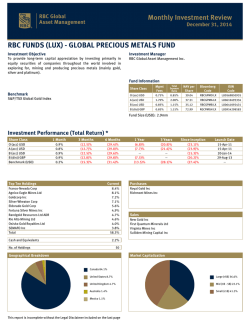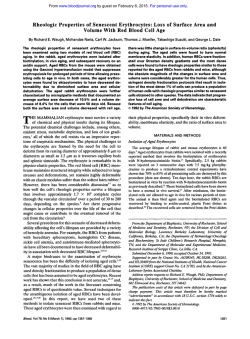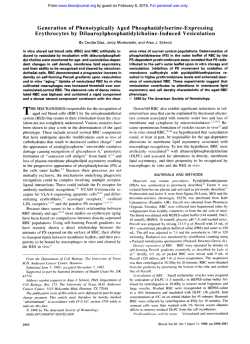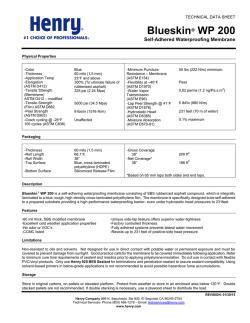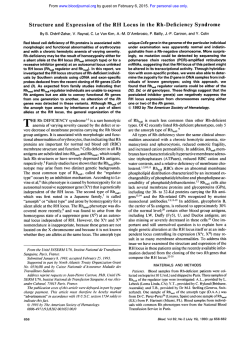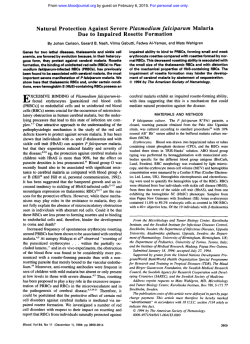
Improved Red Blood Cell Preservation Correlates With Decreased
From www.bloodjournal.org by guest on February 6, 2015. For personal use only. Improved Red Blood Cell Preservation Correlates With Decreased Loss of Bands 3, 4.1, Acetylcholinestrase, and Lipids in Microvesicles By U.J. Dumaswala, R.U. Durnaswala, D.S. Levin, and T.J. Greenwalt In earlier studies we have shown that a final concentration of 0.69% glycerol in blood mixed with anexperimental additive solution, EAS 25, improves the in vitro quality and in vivo survival of red blood cells (RBCs).The objective of this study was to determine if the better preservation of RBCs in EAS 25 is correlated with the improved maintenance of membrane lipids and proteins and decreased vesiculation. Split units of RBCs were stored in Adsol or EAS 25(mmol/L: adenine 2/2, dextrose 122/110, mannitol 42/55, glycerol 0/150, NaCl 154/50). After 12 weeks storage, RBC and microvesicle membranes were analyzed for cholesterol, phospholipid, diphenyl hexatriene fluorescence anisotropy, and acetylcho- linesterase (AchE) activity. Bands 3 and 4.1 were identified in themicrovesicle membranes by immunoblotting. The RBC membrane cholesterol, phospholipids, and AchE remained higher in EAS 25 than inAdsol (P< .001). Vesicle membrane lipids and AchE in EAS 25 were significantly less than in Adsol ( P < .001). The fluidity of stored cells in both thesolutions was greater thanthe prestorage samples. Immunoblotting analyses showed that bands 3 and 4.1 were greatly reduced in themicrovesicle membranes shed by the RBCs stored in EAS 25 compared with those formed in Adsol. 0 1996 by The American Society of Hematology. D tion of approximately 7 5 mmoVL (0.69%) glycerol is less affected, and AchE and lipids are better maintained than in Adsol. Decreased total vesicle membrane proteins with less AchE and bands 3 and 4.1 were found in EAS 25. URING BLOOD BANK storage, red blood cells (RBCs) are transformed from discocytes to spheroechinocytes. Associated changes in their membranes include the loss of acetylcholinesterase (AchE), other membrane proteins, cholesterol, phospholipids, and the shedding of hemoglobin-containing 50 to 200 nm vesicles."' Kadlubowski and Schrier et al"." reported the appearance of high molecular weight complexes, increases in bands 1 plus 2, 4.2, 5 , and 6 and decreases in bands 7 and 8 in the membranes of RBCs stored for 4 to 8 weeks in citrate-phosphate-dextrose or citrate-phosphate-dextrose-adenine-2 solutions. The formation of vesicles has been related to the oxidative damage of spectrin, band 4. l deficiency andthe cross-linking of spectrin.','*." Only traces of bands l and 2 have been found in the vesicle membranes and bands 3, 4.1, and glycophorin A have been demonstrated by immunoblotting and periodic acid Schiff ~ t a i n i n g . ~ , ' ~ . ' ~ Our studies have suggested that improved preservation correlates with decreased RBC vesiculation.15Goals for improvedRBC preservation include decreasing the loss of membrane proteins, lipids, and vesicles. We have previously reported that RBC adenosine triphosphate (ATP) is better maintained and there is less K' leakage and hemolysis in a hypotonic experimental additive solution containing 150 mmoVL glycerol (EAS 25) than in Adsol.l6 Itwas hypothesized that the beneficial effect was due to better maintenance of membrane integrity and decreased vesiculation. We now report that the microviscosity of the membranes of RBCs stored in EAS 25 with a final concentraFrom the Hoxworth Blood Center andthe Children's Hospital Medical Center, University of Cincinnati Medical Center, Cincinnati,OH. Submitted December 2, 1994; accepted October 2, 1995. Supported in part by a National Institutes of Health Grant No. HL 44987 and by a grant from the National Blood Foundation. Address reprint requests to Umakant J. Dumaswala, PhD, Hoxworth Blood Center, University of Cincinnati Medical Center, PO Box 670055, 3130 Highland Ave, Cincinnati, OH 45247-0055. The publication costsof this article were defrayedin part by page charge payment. This article must therefore be hereby marked "advertisement" in accordance with 18 U.S.C. section 1734 solely to indicate this fact. 0 1996 by The American Society of Hematology. 0006-4971/96/8704-0020$3.00/0 1612 MATERIALS AND METHODS Blood donors acceptable by American Associationof Blood Banks and FoodandDrug Administration criteria were used. The protocol was approved by the University Institutional Review Board. Standard units of blood (450 +- 45 mL) were collected with 63 mL citrate-phosphate-dextrose solution in polyvinyl chloride bags (PL 146, Baxter Healthcare Corp, Deerfield, IL) and were centrifuged (RC-3C, Sorvall, Dupont, Wilmington, DE) at 8358 for 10 minutes. The platelet-rich plasma was expressed into a satellite bag. The packed red blood cells (PRBCs) were split aseptically in two aliquots by weight into 300 mL polyvinyl chloride transfer bags. Using a sterile connecting device (SCD 312, Haemonetics Corp, Braintree, MA), 100 mL of an experimental additive solution (EAS 2 5 ) was added to one aliquot, and 50 mL of the commercial additive Adsol to the other. The aliquots were stored lying flat at 1 to 6°C without mixing. Before sampling at 0 and 84 days, they were thoroughly mixed on a platelet agitator (Meddev Corp. Los Altos, CA). Sterility was confirmed by inoculating 1.0 mL of the final samples into tubes of thioglycolate and tryptic soy broth. Preparation of EAS 25. Formulations of the preservation solutions are given in Table 1. The method of preparation was as described." Preparation of RBCs, ghosts, and microvesicles. The RBCs were purified by the method of Beutler et ai1' using a-cellulosemicrocrystalline cellulose columns, as described previously? to eliminate leukocyte and platelet contamination. The purified RBCs were lysed in 30 volumes of 5 mmoUL Na,HPO, buffer, pH 8.0 according to Dodge and Phillips.'x The ghosts were isolated by centrifugation at 38,0008 for 20 minutes and washed five times in the same buffer to obtain hemoglobin-free white ghosts. Microvesicles were isolated as described previously." Briefly, the supernatant was collected after centrifugation of blood at 2,000g for 10 minutes and passed through 0.8 p m nitrocellulose filters (Nuclepore Corp, Pleasanton, CA) in an Amicon filtration system (Amicon Corp, Lexington, MA) at 5 to 10 lbs/sq in N, pressure. The filtrate was centrifuged at 38,OOOg for 1 hour and the isolated vesicle pellet was washed twice with phosphate buffered saline, pH 7.4 containing 2 mmoUL EDTA and 1 mmoUL phenylmethylsulfonylfluoride to prevent proteolysis and stored at -70°C for further studies. RBC and vesicle membrane lipid und juorescence unisotropy analyses. After lipid extraction by the method of Broekhuyse," cholesterol was measured by a coupled enzymatic assay (Sigma Chemical CO, St Louis, MO)" and phospholipid was measured as Blood samples. Blood, Vol 87, No 4 (February 15). 1996: pp 1612-1616 From www.bloodjournal.org by guest on February 6, 2015. For personal use only. 4.1, LIPIDS BANDS 3, AND PRESERVATION IN RBC 1613 Table 1. ComDosition of Additive Solutions (Millimoles Per Liter) Table 3. Effect of Storage on RBC and Vesicle Membrane Fluidity ~~~ Adenine Dextrose Mannitol Glycerol NaCl pH at 25°C Milliosmolality Total Nonpenetrating EAS 25 Adsol 2.0 110.0 55.0 150.0 50.0 7.15 2.0 122.0 42.0 406.0 145.0 475.0 322.0 RBC Ghosts Vesicles Degree of Polarization Pre Adsol (12wk) 0.2121 2 0.0017 0.19722 0.0004* <.001 0.20382 0.0022’ 0.2136 <.001 P 154.0 5.86 =.073 Nonpenetrating milliosmolality represents components that do not penetrate the cell membrane. EAS 25(12 wk) P 0.2058 2 0.0077 2 0.0008 n = 6;mean ? SD. The Pvalues forthe ghosts are basedon comparison to presamples. * P value for Adsol v EAS 25 ghosts after 12 weeks of storage = .04. (IVF 12, courtesy Dr M.L. Jennings, The University of Texas Meditotal lipid phosphorus by the method of Bartlett.21Cholesterol and cal Branch at Galveston, Galveston, TX) to human band 3. The phospholipid concentrations were expressed as pmoVmL RBC, and indicator antibody was a peroxidase-conjugated goat antimouse IgG the molar fractions of cholesteroUphospholipidwere calculated. (Organon Teknika, Durham, NC), and the color development was Fluorescence anisotropy was determined according to the method in the presence of 3,3’ diaminobenzidine and hydrogen peroxide. of Williams and Hazel” using the lipid soluble probe, 1.6-diphenylThe amount of band 3 was determined by densitometric scanning To mini1,3,5-hexatriene (Aldrich Chemical CO, Milwaukee, W). (BioRad, Model 680 video densitometer, Hercules, CA). mize probe-probe interaction, 300 pg of membrane/vesicle protein Band 4.1 protein was localized by treating the blots with a polysamples were suspended in 5 mmoVL Tris-HCI buffer, and the samclonal rabbit antiserum to human band 4.1 (courtesy Dr P. Low, ples were sonicated before fluorescence measurements. All measureIndiana University, Bloomington, IN). The secondary antibody was ments were made at 37°C using a Perkin-Elmer fluorescence spectroperoxidase-conjugated goat antirabbit IgG (Organon Teknika, Durphotometer model 650-10s (Perkin Elmer, Norwalk, CT) equipped ham, NC), and color development was as described above. with a polarizing filter. Measurements were made at an excitation wavelength of 366 nm and an emission wavelength of 430 nm. Membrane proteins. Total proteins were determined by the RESULTS method of Bradford” with Coomassie Brilliant Blue G 250 phosTo simplify comparisons, data are presented in terms of phoric acid reagent. The hemoglobin in the vesicle preparations was units of PRBC volume represented as the denominator. quantified by the micro-Drabkin method modified by the addition of 0.5% Triton X-l00 to lyse the vesicles and clear the t ~ r b i d i t y . ~ ~ Effect of storage media on lipid composition andjuoresThe hemoglobin value was subtracted from the total protein value cence anisotropy. RBC membranes lost more cholesterol to obtain the amount of membrane protein. than phospholipids during storage (Table 2). Though there Acetylcholinesterase activity. The AchE was determined in the was significantly less loss of both cholesterol and phosphomembranes of RBCs and vesicles bythe method of EllmanZ5as lipids after storage for 12 weeks in EAS 25 than in Adsol, modified by Chow and Islam.26 the RBC membrane C/P ratio in both media declined from Localization and quanti$cation of band 3 and 4.1 proteins. Coma 0.83 prevalue to 0.73. Concurrent with changes in lipid parable concentrations of vesicle proteins were analyzed by 10% composition, there were significant changes in lipid fluidity. polyacrylamide gel electrophoresis according to Tsang et al.27The Steady state anisotropy values of RBC membranes decreased fractionated proteins were electroblotted onto 0.2 p-nitrocellulose with storage, the decrease being markedly greater in Adsol membranes for 16 to 18 hours to assure quantitative transfer. The than in EAS 25 (Table 3). The fluidity of the vesicle memblotted samples were reacted with a mouse IgG monoclonal antibody Table 2. Comparison of the Effect of Storage Media on RBC Lipids Cholesterol Phospholipids CIP Iprnollrnl RBCs) ~~~~ branes in Adsol was greater than in EAS 25, but the difference was not significant (Table 3). Cholesterol and phospholipid contents of the vesicles shed in EAS 25 were significantly lower than those in Adsol, but the C/P ratios were not significantly different (Table 4). RBC vesiculation. RBCs stored in EAS 25 shed signifi- ~~ Pre n = 6 ,021 056 Adsol (12wk) n = 11 P <.0001 EAS 25 (12 wk) n = 11 P .3462 3.47 t 0.28 4.17 2 0.16 0.83 2.52 2 0.18’ 3.48 <.0001 -c 0.38* 0.73 2.97 2 0.202* 4.08 ,0007 2 2 0.06 t 0.11 Table 4. Effect of Storage Media on Lipids of Vesicles Collected After 12 Weeks of Storage Cholesterol 0.172’ 0.73 PhosDholiDids CIP t 0.03 Mean t SD. All of the above Pvalues are based on comparing 12week data to presamples. *P < ,001.comparison of Adsol v EAS 25 RBCs at 12 weeks of storage. Adsol EAS 25 P 0.18 t 0.05 0.28 0.09 ? 0.04 0.13 <,0001 n = 12, mean 2 SD. t 0.09 0.65 t 0.05 0.69 0.05 .l95 1.0001 t 0.09 From www.bloodjournal.org by guest on February 6, 2015. For personal use only. DUMASWALA ET AL 1614 Table 5. Effect of Storage Mediaon Proteins of Vesicles Collected After 12 Weeks of Storage Adsol €AS 25 P 0.27 2 0.14 <.0001 kDa - 116 - 97 - 78 rnalrnL RBC 0.65 2 0.22 n = 13, mean 2 SD. Band 4.1 > - 66 cantly less vesicle membrane proteins ( P < .0001) than those stored in Adsol (Table 5). Immunohlot analyses of vesicle membrane hands 3 and 4. I . Band 3 and band 4.1 immunoblots are shown in Figs 1 and 2. Densitometric scanning showed that the amounts of intact bands 3 and 4.1 were lower by 40% ? 7.2% and 51.6% ? 12.4% (n = 5), respectively, in vesicles formed in EAS 25 than in Adsol. The Coomassie blue staining of the - 45 - 14 kDa Adsol EAS 25 at 12 wks at 12 wks - <Band 3 97 -45 -31 -14 Adsol EAS 25 at I2 wks Fig l. Band 3 immunoblots of microvesicles after 12 weeks of storage in Adsol andEAS 25. Blotted membranes were reacted with monoclonal antibody llVF12)t o human band 3, followed by peroxidase-conjugated indicator antibody. The color development was in the presence of 3.3' diaminobenzidine and hydrogenperoxide. Fig 2. Band 4.1 immunoblots of microvesicles after 12 weeks of storage in Adsol andEAS 25. Blotted membranes were reacted with polyclonal rabbit antiserumt o human band 4.1,followed by peroxidase-conjugated indicator antibody. The color development was in the presence of 3.3' diaminobenzidine and hydrogen peroxide. vesicle membrane protein shows a similar decrease of band 3 protein only (Fig 3). AchE activity. AchE activity (Table 6) remained significantly higher in RBCs stored in EAS 25 than in Adsol ( P < .OOOI). At the end of12 weeks of storage, AchE activity of RBCs stored in EAS 25 did notdiffer significantly from the initial values. AchE in EAS 25 vesicles was 4 0 % of that found in Adsol vesicles. DISCUSSION During blood bank storage or accelerated ATP depletion, RBC membranes lose cholesterol, phospholipids, proteins, and shed exocytic microvesicles.'.'.' The microvesicle membranes lack spectrin and ankyrin, but have demonstrable amounts of most of the other peripheral and integral proteins.3.~n.~ I They are selectively enriched in A C ~ E . ' . ~ We .~.'~ have previously shown that RBC vesiculation, hemolysis, and potassium loss in vitro and in vivo recovery are improved in EAS 25.1".2xEAS 25 differs fromAdsolmainly by containing 150 mmol/L (1.38%) glycerol, less NaCI, and hypotonicity of the nonpenetrating ingredients (Table l ) . The data in Table 2 indicate a greater loss of cholesterol (27%) and phospholipids (16.5%) by RBCs stored in Adsol than in EAS 25 (14% and 2%, respectively). The difference in the loss of cholesterol maybe sufficient to account for the greater increase in membrane fluidityfoundin RBCs stored in Adsol (Table 3). Poznansky et al" reported that From www.bloodjournal.org by guest on February 6, 2015. For personal use only. 4.1, BANDS 3, AND LIPIDS IN RBC PRESERVATION 1615 the cholesterol content of RBC membranes markedly affected K' transport. Relatively lower RBC K' leakage observed earlier16 in EAS 25 than in Adsol may be correlated with reduced RBC cholesterol loss in EAS 25. The modest change in the molar cholesterokphospholipid ratios was not sufficient to cause the drastic changes in morphology reported by Cooper et al." The markedly decreased loss of cholesterol, phospholipids, AchE, andproteins by RBC membranes in microvesicles suggests better maintenance of membrane integrity in EAS 25 (Tables 4, 5, and 6). This is supported by the lower amounts of bands 3 and 4.1 in the membranes of the microvesicles shed in EAS 25 thaninAdsol (Figs 1, 2, and 3). It is possible that significantly greater disruption of the linkages between spectrin, bands 3 and 4.1 and between the latter and the glycophorins occurs in Adsol than in EAS 97 - 116 66 - 4s - <Band3 - 97 -4s -31 - 14 Adsal M25 at 12 wks Fig 3. Coomassie blue staining of microvesicle membrane proteins after 12 weeks of storage in Adsol and EAS25. Polyacrylamide gel electrophoresis performed as described in Materials and Methods. Lane 1, high molecular weight standards, lane 4, low molecular weight standards. Table 6. Effect of Storage Media on RBC and Vesicle AchE RBCs Vesicles (mol. hydrolyzed per minute per mL RBCd Pre (1.872 0.31)X IO3 n Adsol (12wk) P n wk) EAS 25 (12 P n 7 (1.30 -C 0.19)X lo3" 0.0002 10 (1.60 2 0.25) X lo3* .062 10 (2.042 0.51) X 10' 12 (1.002 0.39)X IO' <.0001 12 Mean 2 SD. The P values for RBCs are based on comparisons to presamples. P < .0001,comparison of Adsol v EAS 25 RBCs at 12 weeks of storage. 25. One possible reason for this could be the oxidation of sulfhydryl groups in spectrin and protein 4.1.7*13Low levels of protein band 4.1 found in vesicles released from RBCs stored in EAS 25, suggest that there is a better maintenance of this protein in RBCs, resulting in stronger spectrin-actin interaction. This would be ameliorated if the glycerol in EAS 25 serves as a free oxygen radical scavenger." Phosphoinositides have been shown to enhance the interaction of protein 4.1 with the g l y c ~ p h o r i n s . ~Possibly * ~ ~ ~ this relationship will prove to have a bearing on the release of protein 4.1 in vesicle membranes. We have shown that phosphoinositide 4,5-P04, which has the greatest effect on the protein 4.1 and glycophorin linkage, is selectively better represented in RBC vesicles, suggesting perturbation of this linkage.' The effect of the hypoosmolarity of EAS 25 must also be considered. The initial mean corpuscular volume (MCV) of the RBCs in this preservative versus Adsol was 1 13 W90 fL, and after 12 weeks, the values were 100/88 Meryman et al" have suggested that increased membrane tension in hypoosmolar solutions will reduce the shedding of vesicles by RBCs during storage. This has not beenproven.Itis difficult to conceive that this could be a factor in explaining the differences in vesicle membrane composition thatwe have described. Cell swelling and low pH activate the K-Cl cotransport p a t h ~ a y . ~This ' pathwayis active in reticulocytes and the young RBC population and plays a role in regulatory volume decrease (RVD). Under blood bank storage conditions, RVD and the K-Cl cotransport pathway probably do not play a significant role. The conclusions that may be drawn are that the formation of vesicles by RBCs is a complex process that depends on changes in the interactions occurring between the cytoskeleton, peripheral membrane proteins, and lipids. The quantity and structure of the vesicles varies with the nature of the storage medium in which the RBCs were kept. It is suggested that less loss of critical membrane proteins is an indicator of improved RBC preservation. Additional studies are needed for understanding the results reported. They will be the underpinning for the development of formulations for the improved storage of RBCs. From www.bloodjournal.org by guest on February 6, 2015. For personal use only. DUMASWALA ET AL 1616 ACKNOWLEDGMENT Appreciation is expressed to Margaret O'Leary for her assistance in the preparation of this manuscript. REFERENCES I . Rimon S, Brok F, Rimon A: Changes in erythrocytes lipids during storage. Clin Chim Acta 12:22, 1965 2. Trotter J, Rumsby MG: Lipids of the human erythrocyte membrane during storage for transfusion. Correlation of lipid changes with the discocyte to spherocyte shape transformation. J Appl Biochem 3:19, 1981 3. Greenwalt TJ, Bryan DJ, Dumaswala UJ: Erythrocyte membrane vesiculation and changes in membrane composition during storage in citrate-phosphate-dextrose-adenine-]. Vox Sang 47:261, 1984 4. Greenwalt TJ, Bryan BJ, Dumaswala UJ: Some changes in RBC phosphoinositide metabolism during blood bank storage. Blood 66:277a, 1985 S . Dumaswala UJ, Greenwalt TJ: Effect of storage on red blood cell membrane phosphoinositides (PIS) and acetylcholinesterase (AchE). 28th International Conference on the Biochemistry of Lipids, Nottingham, UK, D28, 1987 (abstr) 6. Rumsby MG, Trotter J, Allan D, Michell RH: Recovery of membrane microvesicles from human erythrocytes stored for transfusion. A mechanism for the erythrocyte discocyte-to spherocyte shape transformation. Biochem Soc Trans 5:126, 1977 7. Wagner GM, Chiu J-H, Heath RH, Lubin BH: Spectrin oxidation correlates with membrane vesiculation in stored RBCs. Blood 69: 1777, 1987 8. Weitz M, Bjerrum OJ, Ott P, Brodbeck U: Quantitative composition and characterization of the proteins in membrane vesicles released from erythrocytes by dimyristoylphosphatidylcholine.A membrane system without cytoskeleton. J Cell Biochem 19:179, 1982 9. Hagelberg C, Allan D: Restricted diffusion of integral membrane proteins and polyphosphoinositides leads to their depletion in microvesicles released from human erythrocytes. Biochem J 271:831, 1990 IO. Kadlubowski M: The effect of in-vivo ageing of the human erythrocyte on the proteins of the plasma membrane. A comparison with metabolic depletion and blood bank storage. Int J Biochem 9:79, 1978 1 1. Schrier SL, Sohmer PR, Moore GL, Ma L, Junga I: Red blood cell membrane abnormalities during storage. Correlation with in vivo survival. Transfusion 22:261, 1982 12. Wagner GM, Chiu DT-Y, Yee MC, Lubin BH: Red cell vesiculation-A common membrane physiologic event. J Lab Clin Med 108:315, 1986 13. Wolfe L, Byrne A, Becker P, John K, Lux S: Reversible injury to the red blood cell membrane skeleton during storage. Clin Res 31:486, 1983 14. Lutz HU, Liu S-C, Palek J: Release of spectrin-free vesicles from human erythrocytes during ATP depletion. J Cell Biol 73:548, 1977 15. Greenwalt TJ, Zehner Sostok C, Dumaswala UJ: Studies in redblood cell preservation. 2. Comparison of vesicle fOrInation, morphology, and membrane lipids during storage in AS-l and CPDA-1. Vox Sang 58:90, 1990 16. Dumaswala UJ, Bentley NL, Greenwalt TJ: Studies inred blood cell preservation. 8. Liquid storage of red cells in a glycerolcontaining additive solution. Vox Sang 67:139, 1994 17. Beutler F, West C, Blume K-G: The removal of leukocytes and platelets from whole blood. J Lab Clin Med 88:328, 1976 18. Dodge JT, Phillips GB: Comparison of phospholipids and of phospholipid fatty acids and aldehydes in human red cells. J Lipid Res 8:667, 1967 19. Broekhuyse RM: Improved lipid extraction of erythrocytes. Clin Chim Acta 51:341, 1974 20. Allain CC, Poon LS, Chan CSG, Richmond W, Fu PC: Enzymatic determination of total serum cholesterol. Clin Chem 20:470, 1974 21. Bartlett GR: Phosphorus assay in column chromatography. J Biol Chem 234:466, 1959 22. Williams EE, Hazel JR: Membrane fluidityand hemilayer temperature sensitivity in trout hepatocytes during brief in vitro cold exposure. Am J Physiol 266:R773, 1994 23. Bradford MM: A rapid and sensitive method for the quanititation of microgram quantities of protein utilizing the principles of protein-dye binding. Anal Biochem 72:248, 1976 24. Greenwalt TJ, McGuinness CG, Dumaswala UJ: Studies in red blood cell preservation: 4. Plasma vesicle hemoglobin exceeds free hemoglobin. Vox Sang 61:14, 1991 25. Ellman GL, Courtney KD, Andres Jr V, Featherstone RM: A newandrapid colorimetric determination of acetylcholinesterase activity. Biochem Pharmacol 7:88, 1961 26.Chow CM, Islam MF: Colorimetric determination of red blood cell acetylcholinesterase activity. Clin Biochem 3:295, 1970 27. Tsang VCW, Peralta JM, Simons AR: Enzyme-linked immunoelectrotransfer blot techniques (EITS) for studying the specificities of antigens and antibodies separated by gel electrophoresis, in Langdon JJ, Vanakie HV (eds): Methods in Enzymology, Immunological Techniques, v01 92. New York, NY, Academic, 1983, p 377 28. Greenwalt TJ, Dumaswala UJ, Rugg N: A glycerol additive solution improves red cell viability. Transfusion 34:66S, 1994 (abstr) 29. Poznansky M, Kirkwood D, Solomon AK: Modulation of red cell K' transport by membrane lipids. BiochimBiophysActa 330:3S I , 1973 30. Cooper RA, Arner EC, Wiley JS, Shattil SJ: Modification of red cell membrane structure by cholesterol-rich lipid dispersions. A model for the primary spur cell defect. J Clin Invest 55:115, 1975 3 1. Oberley LW, Sierra E: Radiation sensitivity testing of cultured eukaryotic cells, in Greenwald RA (ed): Handbook of Methods for Oxygen Radical Research. Boca Raton, FL, CRC, 1989, p 417 32. Anderson RA: Regulation of protein 4.1-membrane associations by a phosphoinositide, in Agre P, Rarder JC (eds): Red Blood Cell Membranes: Structure, Function and Clinical Implications. New York, NY, Marcel Dekker, 1989, p 187 33. Pinder JC, Chung A, Reid ME, Gratzer WB: Membrane Attachment sites for the membrane cytoskeletal protein 4. I of the red blood cell. Blood 82:3482, 1993 34. Meryman HT, Hornblower MLS, Syring RL: Prolonged storage of red cells at 4°C. Transfusion 26:500, 1986 35. Olivieri 0, de Franceschi L, de Gioncoli M, Cirelli D, Corrocher R: Potassium loss and cellular dehydration of stored erythrocytes following incubation in autologous plasma: Role of the KC1 cotransport system. Vox Sang 65:95, 1993 From www.bloodjournal.org by guest on February 6, 2015. For personal use only. 1996 87: 1612-1616 Improved red blood cell preservation correlates with decreased loss of bands 3, 4.1, acetylcholinestrase, and lipids in microvesicles UJ Dumaswala, RU Dumaswala, DS Levin and TJ Greenwalt Updated information and services can be found at: http://www.bloodjournal.org/content/87/4/1612.full.html Articles on similar topics can be found in the following Blood collections Information about reproducing this article in parts or in its entirety may be found online at: http://www.bloodjournal.org/site/misc/rights.xhtml#repub_requests Information about ordering reprints may be found online at: http://www.bloodjournal.org/site/misc/rights.xhtml#reprints Information about subscriptions and ASH membership may be found online at: http://www.bloodjournal.org/site/subscriptions/index.xhtml Blood (print ISSN 0006-4971, online ISSN 1528-0020), is published weekly by the American Society of Hematology, 2021 L St, NW, Suite 900, Washington DC 20036. Copyright 2011 by The American Society of Hematology; all rights reserved.
© Copyright 2025
